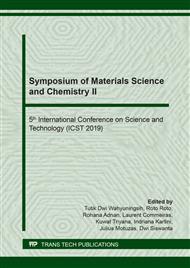[1]
S. Keisandokht, N. Haddad, Y. Gariepy, V. Orsat, Screening the microwave-assisted extraction of hydrocolloids from Ocimum basilicum L. seeds as a novel extraction technique compared with conventional heating-stirring extraction, Food Hydrocoll. 74 (2018) 11–22.
DOI: 10.1016/j.foodhyd.2017.07.016
Google Scholar
[2]
J. Coelho, J. Veiga, A. Karmali, M. Nicolai, C.P. Reis, B. Nobre, A. Palavra, Supercritical CO2 extracts and volatile oil of basil (Ocimum basilicum L.) comparison with conventional methods, Separations 5 (2018) 21–32.
DOI: 10.3390/separations5020021
Google Scholar
[3]
A. Farhat, A.S. Fabiano-Tixier, M. El Maataoui, J.F. Maingonnat, M. Romdhane, F. Chemat, Microwave steam diffusion for extraction of essential oil from orange peel: Kinetic data, extract's global yield and mechanism, Food Chem. 125 (2011) 255–261.
DOI: 10.1016/j.foodchem.2010.07.110
Google Scholar
[4]
A. El Asbahani, K. Miladi, W. Badri, M. Sala, E.H. Ait Addi, H. Casabianca, A. El Mousadik, D. Hartmann, A. Jilale, F.N. Renaud, A. Elaissari, Essential oils: From extraction to encapsulation, Int. J. Pharm. 483 (2015) 220–243.
DOI: 10.1016/j.ijpharm.2014.12.069
Google Scholar
[5]
H.S. Kusuma, M. Mahfud, Microwave-assisted hydrodistillation for extraction of essential oil from patchouli (Pogostemon cablin) leaves, Period. Polytech. Chem. Eng. 61 (2017) 82–92.
DOI: 10.3311/ppch.8676
Google Scholar
[6]
G. Leeke, F. Gaspar, R. Santos, Influence of water on the extraction of essential oils from a model herb using supercritical carbon dioxide, Ind. Eng. Chem. Res. 41 (2002) 2033–(2039).
DOI: 10.1021/ie010845z
Google Scholar
[7]
F.I. Chen, M. Xu, X.Y. Yang, J.L. Liu, Y. Xiao, L. Yang, An improved approach for the isolation of essential oil from the leaves of Cinnamomum longepaniculatum using microwave-assisted hydrodistillation concatenated double-column liquid-liquid extraction, Sep. Purif. Technol. 195 (2018) 110–120.
DOI: 10.1016/j.seppur.2017.12.013
Google Scholar
[8]
J. Chen, X. Yu, Q. Geng, M. Li, Combination of Span 20 and pH-assisted walnut oil extraction during aqueous extraction process, LWT - Food Sci. Technol. 91 (2018) 477–483.
DOI: 10.1016/j.lwt.2018.01.091
Google Scholar
[9]
H. Jahongir, Z. Miansong, I. Amankeldi, Z. Yu, L. Changheng, The influence of particle size on supercritical extraction of dog rose (Rosa canina) seed oil, Journal of King Saud University - Engineering Sciences 31 (2019) 140–143.
DOI: 10.1016/j.jksues.2018.04.004
Google Scholar
[10]
C. Turek, F.C. Stintzing, Stability of essential oils: A review, Compr. Rev. Food Sci. F. 12 (2013) 40–53.
Google Scholar
[11]
L. Mondello, G. Zappia, A. Cotroneo, I. Bonaccorsi, J.U. Chowdhury, M. Yusuf, G. Dugo, Studies on the essential oil-bearing plants of Bangladesh part VIII composition of some Ocimum oils O. basilicum L. var. purpurascens; O. sanctum L. green; O. sanctum L. purple; O. americanum L., citral type; O. americanum L., camphor type, Flavour Fragr. J. 17 (2002) 335–340.
DOI: 10.1002/ffj.1108
Google Scholar


